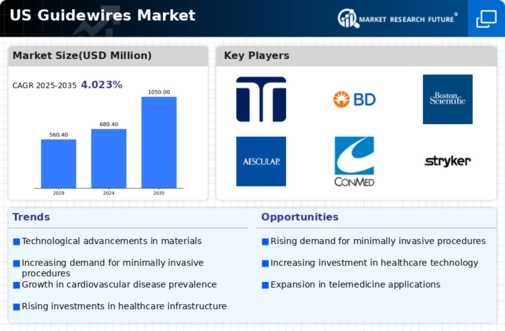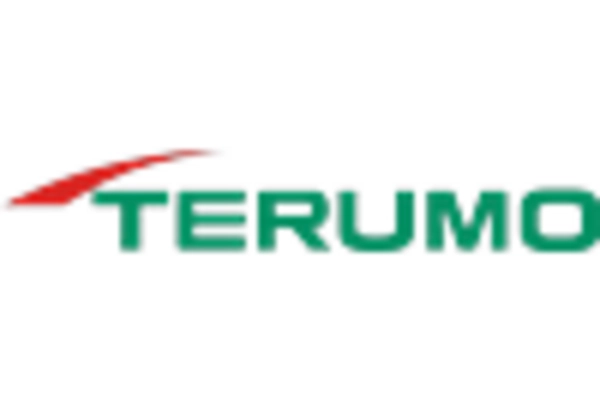Growing Geriatric Population
The increasing geriatric population in the US is a significant factor driving the guidewires market. By 2030, it is projected that around 20% of the US population will be aged 65 and older, leading to a higher prevalence of age-related health issues, including cardiovascular diseases and other chronic conditions. This demographic shift necessitates more frequent medical interventions, where guidewires play a critical role in various procedures. The market is likely to see a corresponding rise in demand for guidewires as healthcare providers adapt to the needs of an aging population. Additionally, the focus on improving the quality of care for elderly patients may lead to increased investments in advanced guidewire technologies, further propelling market growth. The guidewires market is thus positioned to expand in response to these demographic changes.
Focus on Patient-Centric Care
The shift towards patient-centric care in the US healthcare system is influencing the guidewires market. This approach emphasizes personalized treatment plans and improved patient experiences, which often require advanced medical devices, including guidewires. As healthcare providers prioritize patient outcomes, the demand for guidewires that enhance procedural safety and efficacy is likely to increase. The market is witnessing a trend where manufacturers are developing guidewires that cater to specific patient needs, such as those with unique anatomical challenges. This focus on customization and patient satisfaction may drive innovation within the guidewires market, as companies strive to create products that align with the principles of patient-centric care. As a result, the market could experience growth as healthcare systems adapt to these evolving expectations.
Rising Healthcare Expenditure
The upward trend in healthcare expenditure in the US is a crucial driver for the guidewires market. With healthcare spending projected to reach approximately $6 trillion by 2027, there is a growing emphasis on investing in advanced medical technologies, including guidewires. This increase in funding allows healthcare facilities to acquire the latest guidewire innovations, which can enhance procedural efficiency and patient safety. Furthermore, as hospitals and clinics strive to improve patient outcomes, the demand for high-quality guidewires is likely to rise. The competitive landscape of the guidewires market is expected to benefit from this increased investment, as manufacturers innovate to meet the evolving needs of healthcare providers. Consequently, the market is poised for growth as healthcare expenditure continues to rise.
Advancements in Medical Imaging Technologies
The evolution of medical imaging technologies is significantly influencing the guidewires market. Enhanced imaging modalities, such as 3D imaging and fluoroscopy, allow for improved visualization during procedures, which is crucial for the effective use of guidewires. These advancements facilitate precise navigation and placement of guidewires, thereby reducing procedural complications and improving patient outcomes. The US market has seen a surge in the adoption of these technologies, with estimates suggesting a growth rate of around 10% annually. As healthcare facilities invest in state-of-the-art imaging systems, the demand for compatible guidewires is likely to increase. This synergy between imaging and guidewire technologies is expected to drive innovation and expand the market, as clinicians seek to optimize procedural efficiency and safety.
Increasing Prevalence of Cardiovascular Diseases
The rising incidence of cardiovascular diseases in the US is a primary driver for the guidewires market. As per recent statistics, cardiovascular diseases account for approximately 697,000 deaths annually, making them a leading cause of mortality. This alarming trend necessitates advanced medical interventions, including the use of guidewires in various procedures such as angioplasty and stent placements. The guidewires market is expected to benefit from this increasing demand, as healthcare providers seek effective solutions to manage these conditions. Furthermore, the growing awareness of cardiovascular health among the population is likely to drive more patients towards seeking treatment, thereby propelling the market forward. The integration of innovative guidewire technologies could further enhance procedural outcomes, making them indispensable in the management of cardiovascular diseases.

















Leave a Comment